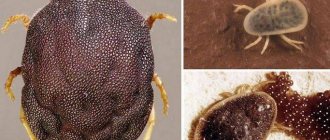Characteristic features of development
The barn mite goes through the following stages of development:
- egg;
- larva with three pairs of limbs;
- nymph of the first age - already has 4 pairs of limbs and becomes similar to an adult;
- a second-instar nymph is an adult arthropod with 8 pairs of limbs and gender.
The transformation process from birth to adulthood takes about two weeks. In total, the life cycle of a barn mite is up to three months.
A feature of the life of the barn tick is the intermediate stage, which can occur between the nymphal stages of the first and second instars. Under unfavorable conditions, the tick goes into the hypopus state. This stage allows the tick to survive the lack of food and moisture. It is covered with a dense shell and does not feed. But it can spread, for example, to the fur of domestic animals or through their excrement. Hypopus is not afraid of any external influences:
- lack of food;
- drying;
- freezing;
- treatment with pesticides;
- ionizing radiation.
The tick experiences difficult times in this state, after which it emerges from this stage as a nymph of the second instar and continues its life, feeding and reproducing.
Winter grain mite - control measures
Winter grain or red-legged mite
– a pest for the temperate climate zone is relatively new. Until recently, it was found only in the subarctic zone, as well as in the southern regions, being a pest of winter crops here, which is why it got its name.
Reasons for expansion of the tick range:
- Climatic changes (milder weather in autumn-spring, cool temperatures without the onset of persistent heat or frost)
- Changes in soil cultivation technology. In fields with minimal cultivation, ticks survive the winter better and increase their numbers;
- Failure to comply with crop rotation.
Maliciousness:











